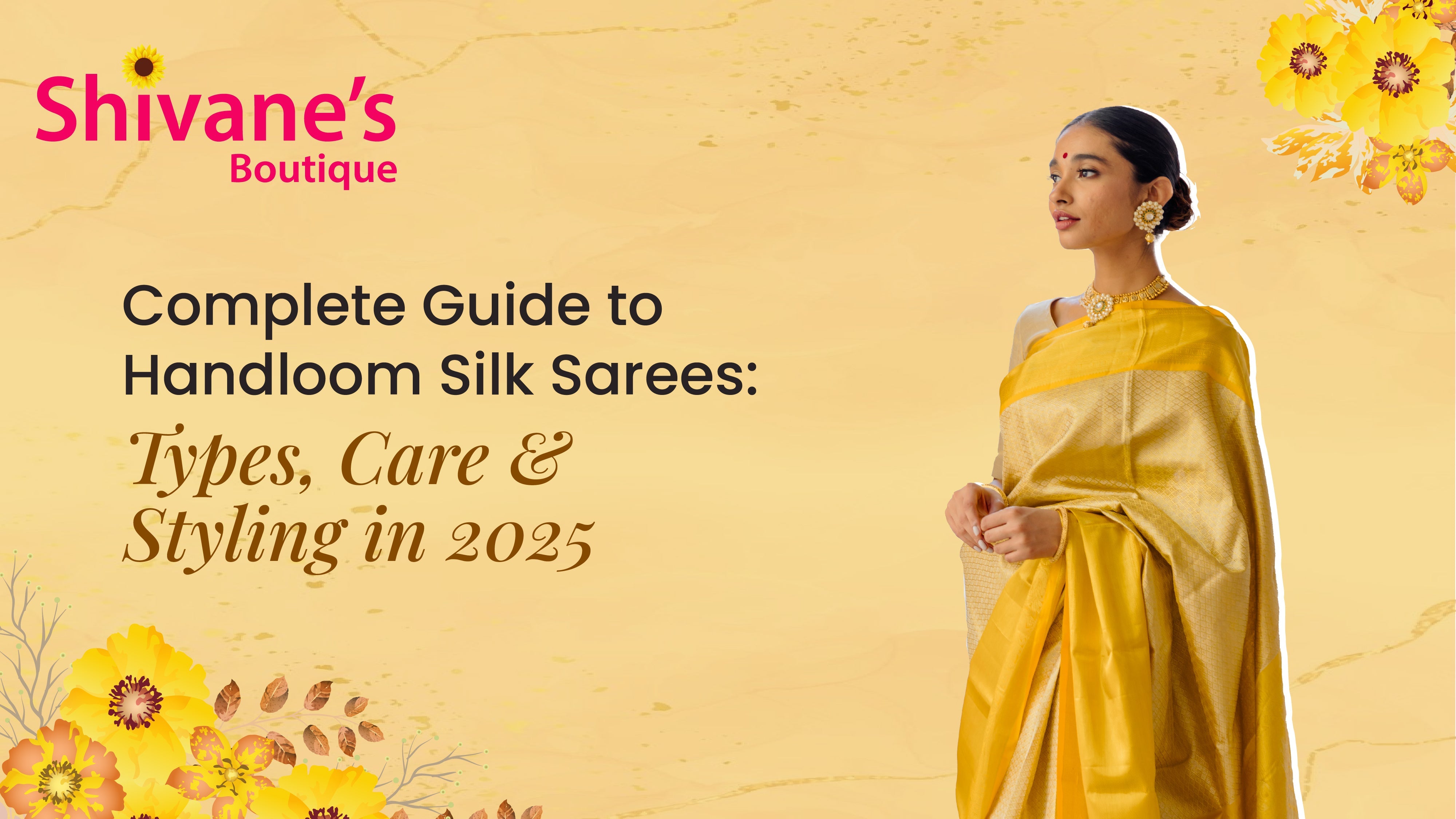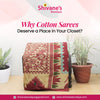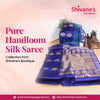Complete Guide to Handloom Silk Sarees: Types, Care & Styling in 2025

The world of handloom silk sarees continues to enchant fashion enthusiasts in 2025, representing the perfect fusion of sustainable craftsmanship and timeless elegance. As conscious fashion becomes increasingly important, pure handloom tussar silk sarees have emerged as the ultimate choice for discerning women who value authenticity, artisan craftsmanship, and environmental responsibility. These exquisite handwoven treasures embody centuries of Indian textile heritage, with each piece telling a unique story of regional artistry and traditional weaving techniques.

At Shivanes Boutique, we celebrate this rich tradition by offering an extensive collection of Pure Handloom Tussar Silk Sarees that combine authentic craftsmanship with contemporary sensibilities perfect for festive celebrations and special occasions. The global handloom silk saree market has witnessed remarkable growth, with consumers increasingly prioritizing authentic, ethically-made textiles that support traditional artisans and preserve cultural heritage. This comprehensive guide explores everything you need to know about handloom silk sarees in 2025, from understanding different types to mastering care techniques and embracing the latest styling trends.
Understanding the Art of Handloom Silk Sarees
The Heritage of Handwoven Craftsmanship
Handloom silk sarees represent the pinnacle of traditional Indian textile artistry, created entirely by skilled artisans using hand-operated looms that have been passed down through generations. The intricate process begins with the preparation of natural silk fibers, which are then dyed using traditional techniques often involving natural colors derived from plants, minerals, and other organic sources, as recognized by the Central Silk Board, the statutory body governing India's silk industry. Each handloom silk saree requires weeks or even months to complete, depending on the complexity of the design, with master weavers incorporating intricate motifs, borders, and pallu patterns that reflect the unique cultural heritage of their respective regions.
The authenticity of handloom silk sarees lies in their imperfections – the slight variations in weave, the organic texture, and the subtle color variations that machine-made textiles cannot replicate. These characteristics not only make each saree unique but also serve as testament to the human skill and artistry involved in their creation. The handloom silk saree weaving process involves the careful interlacing of warp and weft threads, often incorporating metallic zari work, silk threads of different colors, and specialized techniques like ikat, brocade, and jacquard weaving that create the distinctive patterns and textures that define different regional styles.
Regional Heritage and Cultural Significance
The diversity of handloom silk sarees across India reflects the rich tapestry of regional cultures, traditions, and artistic preferences that have evolved over centuries, as documented by the India Handloom Brand initiative. Each state and region has developed its distinctive style, incorporating local motifs, color palettes, and weaving techniques that reflect the area's history, climate, and cultural influences.
South India dominates the handloom silk saree market with a 35% share, led by Tamil Nadu's renowned Kanjivaram sarees and Karnataka's elegant Mysore silk, while the Northeast region shows the highest growth rate at 20% annually.
The cultural significance of handloom silk sarees extends beyond mere clothing – they serve as symbols of prosperity, tradition, and identity, often passed down as heirlooms from mothers to daughters. Many regional varieties hold religious and ceremonial importance, with specific sarees designated for particular festivals, rituals, and life events, supporting the mission of organizations like the National Handloom Development Corporation in promoting sustainable handloom development.
Complete Guide to Handloom Silk Saree Types
Premium Silk Varieties: The Elite Collection
Banarasi silk sarees from Uttar Pradesh represent the epitome of luxury in handloom silk sarees, priced between ₹15,000 to ₹1,50,000 and renowned for their intricate Mughal-inspired zari work featuring floral motifs, paisleys, and elaborate jaals. These handloom silk sarees require exceptional skill to create, with some premium pieces taking up to six months to complete, and their 25-year durability makes them valuable investment pieces for special occasions and bridal trousseau. The heavy silk fabric draped with gold and silver threads creates a regal appearance that has made Banarasi handloom silk sarees the preferred choice for Indian brides and formal ceremonial wear.
Kanjivaram silk sarees from Tamil Nadu, priced between ₹10,000 to ₹80,000, are celebrated for their distinctive temple borders, contrasting color combinations, and exceptional 30-year durability that often exceeds that of other handloom silk sarees. The unique weaving technique involves creating the body and border separately before joining them together, resulting in handloom silk sarees that can literally stand on their own due to the density and quality of the silk. The bold color combinations – deep reds with gold borders, royal blues with contrasting pink, and rich greens with purple accents – make Kanjivaram handloom silk sarees instantly recognizable.
Tussar Silk: The Specialty of Shivanes Boutique
Tussar silk sarees, the specialty of Shivanes Boutique, represent the perfect balance of elegance and accessibility within the handloom silk saree category, priced between ₹8,000 to ₹35,000 with a comfortable 20-year durability and medium care requirements. Our Tussar Sarees Collection showcases the natural texture and distinctive dull gold sheen of tussar silk sarees, woven from wild silk produced by silkworms that feed on oak and Arjun trees. The natural golden hue of tussar silk sarees makes them particularly versatile, complementing all skin tones and providing an elegant foundation for both subtle and bold styling choices.
The appeal of pure handloom tussar silk sarees lies in their versatility – they transition seamlessly from office wear to festive occasions, making them ideal for the modern woman who values both style and practicality. The lighter weight compared to heavily embellished Banarasi or Kanjivaram handloom silk sarees makes tussar silk sarees comfortable for extended wear, while their natural texture provides excellent draping qualities. Our Half Tussar Sarees collection offers additional versatility with mixed fabric options that provide cotton-like comfort with silk elegance.
Regional Specialties and Market Positioning
Chanderi silk sarees from Madhya Pradesh offer lightweight elegance within the handloom silk saree category with their sheer texture and delicate motifs in gold or silver zari, priced affordably between ₹5,000 to ₹25,000. These handloom silk sarees are perfect for daytime events and summer occasions where heavy silk might be uncomfortable, offering sophisticated style without the weight. The signature coin, peacock, and lotus motifs woven into Chanderi handloom silk sarees reflect the region's artistic heritage and make them particularly suitable for contemporary styling approaches.
Muga silk sarees from Assam represent the premium end of the handloom silk saree market, priced between ₹20,000 to ₹1,00,000, with exceptional 35-year durability that makes them valuable long-term investments. The natural golden sheen of Muga handloom silk sarees actually improves with age, developing a richer patina over time that enhances the saree's beauty and value. The rarity of Muga silk, produced exclusively in Assam and certified by the Textiles Committee standards, makes these handloom silk sarees particularly special and sought-after by collectors.
Essential Care Guide for Handloom Silk Sarees
Professional Care Standards for Handloom Silk Sarees
Handloom silk sarees require specialized care to maintain their beauty, texture, and longevity, with dry cleaning being the gold standard for preservation, especially for heavily embellished pieces with zari work. Professional dry cleaning should be performed after every 2-3 wears for handloom silk sarees or when visible soiling occurs, ensuring that harsh chemicals and improper handling don't damage the delicate silk fibers or metallic threads.
When selecting a dry cleaner for your handloom silk sarees, it's essential to choose one with experience in handling silk garments, as improper cleaning can result in color bleeding, texture damage, or dulling of zari work.
For handloom silk sarees without heavy embellishment, careful hand washing is possible using cold water and mild, pH-neutral detergents specifically formulated for delicate fabrics. The washing process for handloom silk sarees requires gentle handling – soaking for no more than 5-10 minutes, avoiding scrubbing or wringing, and ensuring thorough rinsing to remove all detergent residue. Expert care guidance from established sources like Clio Silks emphasizes treating each handloom silk saree as a precious artwork, handling it with clean hands and avoiding sudden movements that could stress the fibers.
Storage Solutions for Handloom Silk Sarees
Proper storage is crucial for maintaining handloom silk sarees in pristine condition, requiring cool, dry environments with humidity levels below 50% to prevent mold, mildew, and fiber degradation. Each handloom silk saree should be wrapped in soft muslin or cotton cloth that allows the fabric to breathe while protecting it from dust, insects, and light exposure. Plastic covers must be avoided as they trap moisture and can cause handloom silk sarees to yellow or the zari to oxidize and turn black over time.
The folding technique for handloom silk sarees requires regular attention – changing fold lines every few months prevents permanent creases from forming and maintains the fabric's flexibility. Acid-free tissue paper should be placed between folds to prevent direct fabric-to-fabric contact in handloom silk sarees, while the storage location should be away from direct sunlight and heat sources that can cause fading and fiber weakening. For valuable handloom silk sarees, consider using breathable fabric storage boxes with compartments that allow sarees to lie flat without excessive folding, as recommended by silk care experts.
Emergency Care for Handloom Silk Sarees
Immediate action is crucial when dealing with stains on handloom silk sarees – gently blotting with cold water and a soft, clean cloth can prevent stains from setting, while rubbing or scrubbing can permanently damage the fabric. For oil-based stains on handloom silk sarees, apply a small amount of talcum powder to absorb the oil before seeking professional treatment, while water-based spills should be blotted and allowed to air dry naturally. Never attempt to remove stubborn stains from handloom silk sarees using household products or harsh chemicals, as these can cause irreversible damage to silk fibers and color fastness.
Regular maintenance includes airing handloom silk sarees every 2-3 months, even if not worn, to prevent fabric stiffening and moth infestations. Natural moth repellents such as neem leaves, eucalyptus sachets, or lavender can be placed in storage areas to protect handloom silk sarees against insect damage without exposing them to harsh chemicals. For long-term preservation of handloom silk sarees, annual inspection and professional cleaning ensure that any developing issues are addressed before they become permanent problems.
2025 Styling Trends for Handloom Silk Sarees
Revolutionary Color Trends in Handloom Silk Sarees
The handloom silk saree color trends for 2025 embrace both earthy sophistication and bold statement-making, with Pantone's Mocha Mousse leading the palette alongside calming lavender, vibrant magenta, and sustainable earth tones. This year's trending colors for handloom silk sarees reflect a growing consciousness about natural dyes and environmentally-friendly dyeing processes, with 65% market preference for these authentic color stories over synthetic alternatives.
Shivanes Boutique's collection of Pure Handloom Tussar Silk Sarees perfectly captures this trend, offering natural golden hues that complement the earthy color palette while maintaining the timeless elegance that defines quality handloom silk sarees.
Pastel palettes are experiencing unprecedented popularity in handloom silk sarees for 2025, with peach, mint, and lemon yellow dominating the spring-summer collections, while deeper autumn tones like bottle green, rust orange, and burnt coral are perfect for wedding seasons. The versatility of handloom silk sarees allows for creative color experimentation, with modern brides choosing unconventional hues like lilac and sage green for their reception wear, moving away from traditional reds and maroons. Metallic neutrals including champagne gold and rose gold continue to reign supreme for evening events in handloom silk sarees, offering sophisticated glamour that photographs beautifully.
Contemporary Blouse Innovations for Handloom Silk Sarees
Handloom silk saree styling in 2025 places unprecedented emphasis on blouse design, with statement sleeves, high necklines, and crop tops leading the trend with 70% market preference. Puff sleeves are experiencing a major revival in handloom silk saree styling, drawing inspiration from vintage aesthetics while adding feminine charm to traditional silhouettes. Bell sleeves and ruffle sleeves offer additional drama for handloom silk sarees, creating visual interest and movement that complements the natural drape of these handwoven textiles.
High-neck blouse designs are dominating formal occasions for handloom silk sarees, adding sophistication and elegance that pairs beautifully with the rich textures of handwoven silks. Back detailing has become a focal point in handloom silk saree styling, with backless designs adorned with tie details, tassels, and mirror work creating stunning visual impact when the pallu is draped elegantly. The modern approach to handloom silk saree blouse styling includes asymmetrical cuts, corset-inspired designs, and cape-style blouses that transform traditional sarees into contemporary fashion statements.
Revolutionary Draping Techniques for Handloom Silk Sarees
The draping landscape for handloom silk sarees in 2025 showcases innovative techniques that blend traditional methods with contemporary aesthetics, with belted drapes, pant-style draping, and mermaid silhouettes gaining popularity among fashion-forward women. The belted handloom silk saree drape represents the perfect marriage of tradition and modernity, using statement belts to create structure and definition while maintaining the graceful flow of handwoven silks. This technique works particularly well with tussar silk sarees from our collection, where the natural texture and weight provide ideal draping qualities for secure belt placement.
Pre-draped handloom silk sarees are revolutionizing the market, offering busy professionals and young women the elegance of handwoven silks without the complexity of traditional draping. The mermaid drape creates a figure-hugging silhouette that narrows at the waist and flares at the bottom, perfect for cocktail parties and evening events where contemporary glamour meets traditional handloom silk saree elegance. The pant-style draping offers unprecedented comfort and mobility for handloom silk sarees, allowing women to wear them to corporate events and casual occasions where traditional draping might be impractical.
Sustainable Fashion Integration with Handloom Silk Sarees
The sustainable fashion movement has positioned handloom silk sarees at the forefront of conscious consumption, with 85% market preference for handloom revival and natural dyeing processes. This trend perfectly aligns with Shivanes Boutique's commitment to authentic Pure Handloom Tussar Silk Sarees, supporting traditional artisan communities while providing customers with genuinely sustainable fashion choices. The growing awareness of fashion's environmental impact has led consumers to prioritize quality over quantity, making the exceptional 20-year durability of handloom silk sarees an attractive investment for environmentally conscious wardrobes.
Repurposing and upcycling handloom silk sarees has become a significant trend in 2025, with creative women transforming old sarees into dupattas, jackets, blouses, and even home décor items, extending the garment's lifecycle and reducing textile waste. The natural biodegradability of silk fibers and the traditional dyeing processes used in authentic handloom silk saree production make these sarees environmentally responsible choices that align with global sustainability goals. The story behind each handloom silk saree – the artisan who created it, the traditional techniques employed, and the cultural heritage preserved – adds emotional value that fast fashion cannot replicate.
Market Insights and Regional Preferences
South Indian Dominance in Handloom Silk Sarees
The handloom silk saree market demonstrates clear regional preferences, with South India commanding a dominant 35% market share and an average purchase price of ₹25,000, reflecting the region's deep-rooted appreciation for premium silk textiles and traditional craftsmanship. Tamil Nadu's position as a major silk production center, home to both Kanjivaram weaving and Shivanes Boutique's operations in Tirunelveli and Madurai, contributes significantly to this regional dominance in handloom silk sarees. The South Indian preference for rich, heavily worked handloom silk sarees aligns perfectly with ceremonial requirements for weddings, festivals, and religious occasions where these handwoven textiles serve as essential cultural attire.
West India shows the highest average purchase price for handloom silk sarees at ₹35,000, reflecting the region's preference for premium varieties like Paithani and Patola sarees, though with slower 8% growth rates indicating market maturity. East India, with its rich tradition of Baluchari and Jamdani handloom silk sarees, maintains 15% market share with competitive pricing at ₹18,000 average, while showing healthy 15% growth rates that suggest increasing appreciation for these artistic textile traditions. The Northeast region, despite holding only 5% market share in handloom silk sarees, demonstrates remarkable 20% annual growth, driven by rising recognition of Muga and Eri silk's unique qualities.
Emerging Trends in Handloom Silk Saree Market
The handloom silk saree market in 2025 reflects evolving consumer priorities, with younger demographics increasingly valuing authenticity, sustainability, and cultural connection over pure luxury positioning. This shift benefits specialties like tussar silk sarees offered by Shivanes Boutique, where the natural texture, moderate pricing, and ethical production methods align perfectly with millennial and Gen Z values. The growing influence of social media and fashion bloggers has democratized handloom silk saree styling knowledge, leading to increased experimentation with draping techniques and fusion styling approaches that make these handwoven textiles accessible to broader audiences.
Digital platforms and online boutiques have revolutionized the handloom silk saree market, enabling artisans and specialized retailers like Shivanes Boutique to reach global customers while maintaining direct connections to traditional weaving communities. The trend toward personalized shopping experiences, including virtual consultations and custom color matching, has made premium handloom silk sarees more accessible to consumers who previously might have been intimidated by the traditional shopping process. This digital transformation, combined with worldwide delivery options, has expanded the market for authentic handloom silk sarees while preserving the personal relationships that define traditional textile commerce.
Styling Handloom Silk Sarees for Different Occasions
Festive and Ceremonial Wear with Handloom Silk Sarees
Handloom silk sarees excel in festive settings where tradition meets celebration, with tussar silk sarees from Shivanes Boutique offering the perfect balance of elegance and comfort for extended wear during festivals, pujas, and family gatherings. For Diwali and other major festivals, rich colors like deep reds, royal blues, and traditional golds complement the golden undertones of handloom tussar silk sarees, while the natural texture provides sophisticated backdrop for statement jewelry and accessories. The 20-year durability of handloom silk sarees makes them excellent investments for building a festival wardrobe that will serve beautifully across multiple seasons and celebrations.
Wedding occasions require careful consideration of the ceremony type and regional customs, with handloom silk sarees offering versatility for different events within the same celebration. For South Indian weddings, the natural gold sheen of tussar silk sarees complements temple jewelry and traditional gold ornaments, while their lighter weight compared to heavy Kanjivaram handloom silk sarees provides comfort during lengthy ceremonies. The key to successful wedding styling with handloom silk sarees lies in balancing the saree's inherent elegance with appropriate accessories – heavier jewelry and bold makeup for evening receptions, more subtle styling for daytime ceremonies.
Professional and Social Settings with Handloom Silk Sarees
The versatility of handloom silk sarees, particularly tussar silk varieties, extends to professional settings where appropriate styling can create sophisticated, office-appropriate looks that honor tradition while meeting modern workplace requirements. The natural texture and moderate sheen of handloom tussar silk sarees work exceptionally well with contemporary blouse designs like high necks or three-quarter sleeves, paired with minimal jewelry and sleek hairstyles for professional presentations or corporate events. The comfort factor of handloom silk sarees makes them practical for long workdays or professional conferences where mobility and comfort are essential.
Social occasions including cocktail parties, art gallery openings, and cultural events provide perfect opportunities to experiment with modern draping techniques and fusion styling approaches with handloom silk sarees. The belt drape technique works particularly well with tussar silk sarees, creating structured silhouettes that photograph beautifully for social media while maintaining traditional elegance. Contemporary accessories like statement belts, modern jewelry, and sleek clutches can transform handloom silk sarees into fashion-forward ensembles that compete with any Western formal wear while celebrating Indian textile heritage.
Investment Value of Handloom Silk Sarees
Financial Benefits and Value Retention
Handloom silk sarees represent exceptional investment value, with premium pieces often appreciating over time due to their scarcity, craftsmanship quality, and cultural significance. Tussar silk sarees from Shivanes Boutique, priced accessibly between ₹8,000 to ₹35,000, offer outstanding value proposition with 20-year durability and moderate care requirements that minimize ongoing maintenance costs. When calculated on a cost-per-wear basis, these handloom silk sarees often prove more economical than contemporary formal wear, especially considering their versatility across multiple occasions and styling approaches.
The growing appreciation for handloom silk sarees in global markets has created opportunities for value appreciation, particularly for authentic pieces with proper documentation and provenance. Handloom silk sarees from established regions and reputable retailers like Shivanes Boutique maintain better resale value due to their authenticity guarantees and quality reputation. The increasing rarity of genuine handloom products, as machine production expands, makes authentic handloom silk sarees more valuable over time, creating natural hedge against inflation while providing ongoing utility and enjoyment.
Cultural Heritage and Emotional Investment
Beyond financial considerations, handloom silk sarees offer immeasurable cultural and emotional value that connects wearers to centuries of textile tradition and artistic heritage. Each tussar silk saree carries the story of its creation – the silkworms that produced the fiber, the artisans who wove the fabric, and the cultural traditions that inspired the design. This connection to living heritage provides emotional satisfaction and cultural pride that mass-produced garments cannot replicate.
The heirloom potential of handloom silk sarees creates lasting family connections, with well-maintained pieces often passed down through generations as symbols of cultural continuity and family tradition. Shivanes Boutique's commitment to authentic Pure Handloom Tussar Silk Sarees ensures that customers receive not just clothing, but cultural artifacts that will maintain their beauty and significance for decades. The knowledge that each handloom silk saree purchase supports traditional artisan communities and helps preserve endangered weaving techniques adds social value that makes every saree a meaningful contribution to cultural preservation.
Choosing Your Perfect Handloom Silk Saree
Authenticity and Quality Verification
When shopping for handloom silk sarees, authenticity verification is crucial to ensure you're investing in genuine handwoven textiles rather than machine-made imitations. Look for recognized certifications such as the Handloom Mark Scheme certification provided by the Textiles Committee, which guarantees that the product is genuinely handwoven. Shivanes Boutique ensures all our Pure Handloom Tussar Silk Sarees meet these authenticity standards, providing customers with certified handwoven textiles that support traditional artisan communities.
The quality of handloom silk sarees can be assessed through several key indicators: evenness of weave (slight irregularities are normal and desirable), color consistency, border alignment, and overall finishing. Authentic handloom silk sarees will have natural variations that machine-made alternatives cannot replicate, including slight thickness variations and organic texture that speaks to their handcrafted origin. When purchasing online, reputable retailers like Shivanes Boutique provide detailed product descriptions, high-quality images, and authenticity guarantees that help customers make informed decisions.
Size, Fit, and Styling Considerations
Handloom silk sarees typically come in standard measurements of 5.5-6 meters length with separate blouse pieces, allowing for various draping styles and body types. The weight and texture of different handloom silk sarees significantly impact draping and comfort – lighter varieties like tussar silk sarees are ideal for extended wear and warm weather, while heavier silks like Kanjivaram are better suited for special occasions and formal events. Our Half Tussar Sarees collection offers mixed fabric options that provide the elegance of silk with added comfort for daily wear.
Consider your lifestyle, occasion requirements, and maintenance capacity when selecting handloom silk sarees. Tussar silk sarees with medium care requirements are perfect for regular wear, while heavily embellished varieties require professional cleaning and careful storage. Shivanes Boutique offers worldwide delivery, making it easy for customers globally to access authentic handloom silk sarees with detailed care instructions and styling guidance.
Conclusion
Handloom silk sarees represent the perfect synthesis of traditional artistry, sustainable fashion, and contemporary style, making them essential wardrobe investments for the conscious consumer in 2025. As the fashion world increasingly values authenticity, sustainability, and cultural connection, these handwoven masterpieces offer everything modern women seek – beauty, versatility, environmental responsibility, and meaningful cultural engagement. Shivanes Boutique's specialization in Pure Handloom Tussar Silk Sarees positions us at the forefront of this movement, offering customers authentic, high-quality pieces that celebrate traditional craftsmanship while meeting contemporary styling needs.
The comprehensive care guidelines, styling innovations, and market insights presented in this guide demonstrate that handloom silk sarees are not merely clothing – they are investments in personal style, cultural heritage, and sustainable fashion practices that benefit both wearers and artisan communities. With proper care, these sarees will provide decades of elegant service while appreciating in both financial and sentimental value. The 2025 trends toward earthy colors, sustainable practices, and fusion styling perfectly complement the natural beauty and versatility of handloom silk sarees, making this an ideal time to begin or expand your collection.
Whether you're building a bridal trousseau, expanding your festive wardrobe, or seeking sustainable fashion alternatives, handloom silk sarees offer unmatched combination of beauty, quality, and cultural significance that will serve you beautifully for years to come. Shivanes Boutique's worldwide delivery ensures that the finest Pure Handloom Tussar Silk Sarees are accessible to discerning customers everywhere, bringing the authentic elegance of traditional Indian textiles to your wardrobe with the convenience of modern retail service.
Related Collections:
-
Pure Handloom Tussar Silk Saree - Our premium collection
-
Tussar Sarees - Complete range
-
Half Tussar Sarees - Mixed fabric comfort
For personalized styling advice and care guidance, contact our experts at our Tirunelveli and Madurai stores or explore our complete collection online with worldwide shipping available.
 Free Shipping across India
Free Shipping across India Shipping Worldwide
Shipping Worldwide




